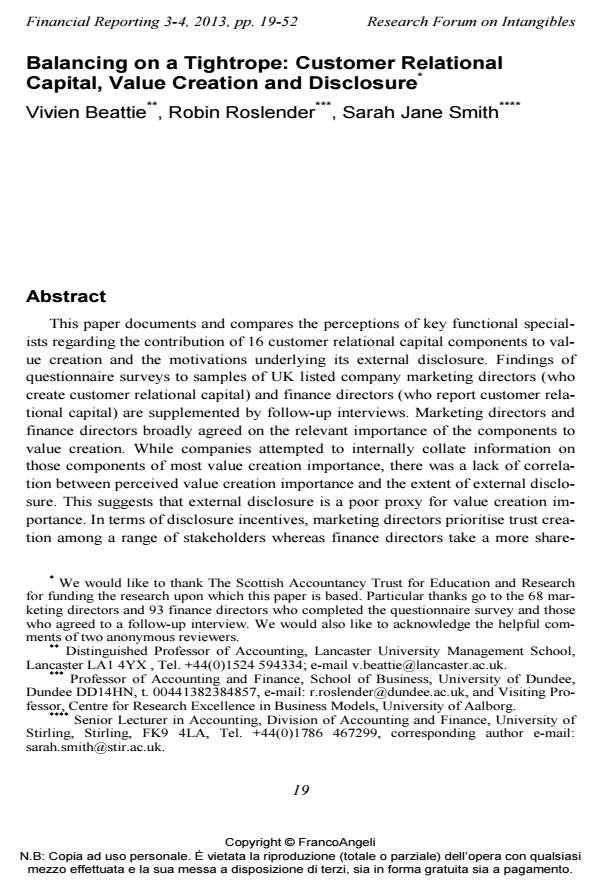Balancing on a Tightrope: Customer Relational Capital, Value Creation and Disclosure
Journal title FINANCIAL REPORTING
Author/s Vivien Beattie, Robin Roslender, Sarah Jane Smith
Publishing Year 2014 Issue 2013/3-4
Language English Pages 34 P. 19-52 File size 315 KB
DOI 10.3280/FR2013-003003
DOI is like a bar code for intellectual property: to have more infomation
click here
Below, you can see the article first page
If you want to buy this article in PDF format, you can do it, following the instructions to buy download credits

FrancoAngeli is member of Publishers International Linking Association, Inc (PILA), a not-for-profit association which run the CrossRef service enabling links to and from online scholarly content.
This paper documents and compares the perceptions of key functional specialists regarding the contribution of 16 customer relational capital components to value creation and the motivations underlying its external disclosure. Findings of questionnaire surveys to samples of UK listed company marketing directors (who create customer relational capital) and finance directors (who report customer relational capital) are supplemented by follow-up interviews. Marketing directors and finance directors broadly agreed on the relevant importance of the components to value creation. While companies attempted to internally collate information on those components of most value creation importance, there was a lack of correlation between perceived value creation importance and the extent of external disclosure. This suggests that external disclosure is a poor proxy for value creation importance. In terms of disclosure incentives, marketing directors prioritise trust creation among a range of stakeholders whereas finance directors take a more share holder-centric perspective. External disclosure attracts new customers and informs other stakeholders, yet may adversely affect relationships with existing customers and/or breach specific non-disclosure agreements or generic industry restrictions and regulations. Harming competitive position is considered the major disclosure disincentive. In the view of marketing directors, managing the external disclosure of relational capital is akin to balancing on a tightrope.
Keywords: Customer relational capital; intellectual capital; value creation; marketing directors; disclosure. First submission: 28 April 2013 accepted: 10 October 2013
- Doing Business with the State and Firms’ Growth. Grasping Invisible Relational Capital Nino Serdarević, Ajla Muratović-Dedić, Inela Karić, in Scientific Annals of Economics and Business /2016 pp.415
DOI: 10.1515/saeb-2016-0131
Vivien Beattie, Robin Roslender, Sarah Jane Smith, Balancing on a Tightrope: Customer Relational Capital, Value Creation and Disclosure in "FINANCIAL REPORTING" 3-4/2013, pp 19-52, DOI: 10.3280/FR2013-003003